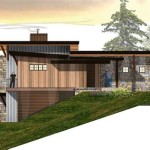House plans for 4 bedroom houses refer to detailed drawings or blueprints that provide a comprehensive guide for the construction and design of a house with four bedrooms. These plans typically include floor plans, elevations, cross-sections, and other construction details to ensure the house meets building codes, structural requirements, and the specific needs of the homeowner. For instance, a house plan for a 4-bedroom house might include different layouts for the bedrooms, bathrooms, living spaces, and other functional areas, as well as specifications for materials, finishes, and appliances.
Having well-defined house plans is essential for any construction project, as they serve as the roadmap for contractors and builders to follow throughout the process. They help ensure accuracy, efficiency, and compliance with building regulations. Moreover, house plans allow homeowners to visualize the final product and make informed decisions about the design and functionality of their future home.
In the following sections, we will explore key considerations when selecting house plans for 4 bedroom houses, provide examples of popular designs, and discuss the benefits of working with an architect or designer to create custom plans that meet your specific requirements.
When selecting house plans for 4 bedroom houses, there are several key points to consider:
- Number of bathrooms
- Layout and flow
- Style and finishes
- Lot size and orientation
- Budget and timeline
- Energy efficiency
- Resale value
- Personal preferences
It’s important to carefully evaluate these factors and consult with an architect or designer to create a plan that meets your specific needs and preferences.
Number of bathrooms
The number of bathrooms in a 4-bedroom house is an important consideration that impacts both functionality and resale value. Here are some key points to think about:
1. Standard vs. Ideal: For a 4-bedroom house, the standard number of bathrooms is two to three. Two bathrooms is typically considered the minimum, with one full bathroom (including a bathtub or shower) and one half bathroom (with a toilet and sink). Three bathrooms provide more convenience and privacy, especially if there are multiple people living in the house.
2. Full vs. Half Bathrooms: Full bathrooms include a toilet, sink, and bathtub or shower, while half bathrooms only have a toilet and sink. Half bathrooms are typically smaller and less expensive to build, but they may not be as convenient for families with young children or guests who are staying overnight.
3. Location and Accessibility: The location and accessibility of the bathrooms are also important considerations. The main bathroom is typically located near the bedrooms, while the half bathroom is often placed on the first floor for guests. It’s important to ensure that all bathrooms are easily accessible from the main living areas.
4. Resale Value: The number of bathrooms can impact the resale value of a house. Houses with more bathrooms tend to be more desirable to buyers, especially families with children. Adding an additional bathroom can be a worthwhile investment if you plan on selling the house in the future.
Layout and flow
The layout and flow of a 4-bedroom house plan refers to the arrangement and connectivity of the different rooms and spaces within the house. A well-designed layout creates a comfortable and functional living environment, while a poorly designed layout can make the house feel cramped, inefficient, and unwelcoming.
Here are some key points to consider when evaluating the layout and flow of a 4-bedroom house plan:
- Openness and Connectivity: Open floor plans have become increasingly popular in recent years, as they create a more spacious and inviting atmosphere. Open floor plans typically combine the living room, dining room, and kitchen into one large space, with minimal walls or barriers. This type of layout promotes interaction and communication between family members and guests, and it can also make the house feel larger than it actually is.
- Traffic Flow: It’s important to consider the flow of traffic when designing a 4-bedroom house plan. The main entryway should lead into a central area of the house, with easy access to the living room, kitchen, and other common areas. Bedrooms and bathrooms should be located in a separate wing or on a different floor to minimize noise and disruption in the main living areas.
- Privacy and Separation: While open floor plans are popular, it’s also important to have separate and private spaces in a 4-bedroom house plan. The bedrooms should be located away from the main living areas to provide a quiet and restful environment. Bathrooms should also be private and easily accessible from the bedrooms.
- Natural Light and Ventilation: A well-designed layout will take advantage of natural light and ventilation. Windows and skylights should be placed strategically to maximize natural light and reduce the need for artificial lighting. Cross-ventilation can also be used to create a more comfortable and healthy indoor environment.
By carefully considering the layout and flow of a 4-bedroom house plan, you can create a home that is both functional and enjoyable to live in.
Style and finishes
The style and finishes of a 4-bedroom house plan play a significant role in determining the overall look and feel of the home. From the exterior facade to the interior decor, every element contributes to the aesthetic appeal and character of the house.
Exterior Style: The exterior style of a 4-bedroom house plan can vary widely, from traditional to modern and everything in between. Popular exterior styles include:
- Traditional: Traditional exteriors are characterized by symmetrical lines, pitched roofs, and classic details such as columns, shutters, and moldings.
- Modern: Modern exteriors are typically more minimalist and geometric, with clean lines, flat roofs, and large windows.
- Craftsman: Craftsman exteriors are known for their natural materials, such as wood and stone, and their emphasis on craftsmanship and detail.
- Mediterranean: Mediterranean exteriors are inspired by the architecture of the Mediterranean region, with features such as stucco walls, tile roofs, and arched windows and doorways.
Interior Finishes: The interior finishes of a 4-bedroom house plan include the materials and colors used for walls, floors, ceilings, and fixtures. Popular interior finishes include:
- Hardwood floors: Hardwood floors are a classic and durable choice for flooring, and they can add warmth and elegance to any room.
- Tile floors: Tile floors are another popular choice for flooring, and they are especially well-suited for kitchens and bathrooms because they are easy to clean and maintain.
- Carpet: Carpet is a soft and comfortable choice for flooring, and it can help to reduce noise levels in a room.
- Paint: Paint is a versatile and affordable way to add color and style to a room. It can be used to create a variety of looks, from classic to modern.
When selecting the style and finishes for a 4-bedroom house plan, it’s important to consider both personal preferences and the overall design of the home. The style and finishes should complement each other and create a cohesive and inviting living space.
Lot size and orientation
The lot size and orientation are important factors to consider when choosing house plans for a 4-bedroom house. The lot size will determine the overall size of the house and the amount of outdoor space available. The orientation of the lot will affect the amount of sunlight the house receives and the views from the windows.
- Lot size: The lot size will determine the overall size of the house and the amount of outdoor space available. A larger lot will allow for a larger house and more outdoor space, while a smaller lot will require a smaller house and less outdoor space. It’s important to choose a lot size that is appropriate for your needs and budget.
- Lot orientation: The orientation of the lot will affect the amount of sunlight the house receives and the views from the windows. A lot that faces south will receive more sunlight than a lot that faces north. A lot with a view of a lake or other natural feature can be a valuable asset. It’s important to choose a lot orientation that maximizes the natural light and views available.
Here are some additional factors to consider when choosing a lot size and orientation for a 4-bedroom house:
- Building codes and setbacks: Building codes and setbacks will dictate the minimum lot size and the distance that the house must be set back from the property lines. It’s important to check with the local building department to determine the specific requirements for your area.
- Zoning restrictions: Zoning restrictions may limit the type of house that can be built on a particular lot. For example, some zoning districts may only allow single-family homes, while others may allow multi-family homes or commercial buildings. It’s important to check with the local zoning board to determine the specific restrictions for your area.
- Personal preferences: Ultimately, the best lot size and orientation for a 4-bedroom house will depend on your personal preferences. If you want a large house with a lot of outdoor space, you will need to choose a larger lot. If you prefer a smaller house with less outdoor space, you can choose a smaller lot. The orientation of the lot will also depend on your personal preferences. If you want a house that receives a lot of sunlight, you will need to choose a lot that faces south. If you prefer a house with a view of a lake or other natural feature, you will need to choose a lot that has that view.
Budget and timeline
The budget and timeline are two important factors to consider when planning to build a 4-bedroom house. The budget will determine the size and quality of the house, as well as the materials and finishes used. The timeline will determine how long it will take to complete the project.
- Budget: The budget for a 4-bedroom house will vary depending on the size, style, and location of the house. A larger house will typically cost more to build than a smaller house. A more complex style will also cost more to build than a simpler style. And a house in a desirable location will typically cost more to build than a house in a less desirable location.
- Timeline: The timeline for building a 4-bedroom house will vary depending on the size and complexity of the project. A smaller, simpler house can typically be built in a shorter amount of time than a larger, more complex house. The timeline can also be affected by the weather and other factors.
- Planning: It is important to carefully plan the budget and timeline for building a 4-bedroom house. This will help to ensure that the project is completed on time and within budget.
- Contingency plan: It is also important to have a contingency plan in place in case of unexpected delays or expenses. This will help to ensure that the project is completed successfully, even if there are unforeseen challenges.
By carefully considering the budget and timeline, you can help to ensure that your dream of building a 4-bedroom house becomes a reality.
Energy efficiency
Energy efficiency is an important consideration when choosing house plans for a 4-bedroom house. An energy-efficient house can save you money on your energy bills and help to reduce your carbon footprint. Here are a few things to look for in an energy-efficient house plan:
1. Insulation: Insulation is one of the most important factors in determining the energy efficiency of a house. Insulation helps to keep the heat in during the winter and the cool air in during the summer. Look for house plans that specify the type and thickness of insulation that will be used in the walls, roof, and floors.
2. Windows and doors: Windows and doors are another important factor in determining the energy efficiency of a house. Look for house plans that specify energy-efficient windows and doors. Energy-efficient windows and doors have a low U-factor and a high Solar Heat Gain Coefficient (SHGC). The U-factor measures how well a window or door resists heat flow. The SHGC measures how well a window or door allows sunlight to pass through.
3. Appliances: The appliances you choose for your home can also affect the energy efficiency of your house. Look for appliances that have the Energy Star label. Energy Star appliances meet strict energy efficiency standards set by the U.S. Environmental Protection Agency (EPA).
4. HVAC system: The HVAC system is responsible for heating and cooling your home. Look for house plans that specify an energy-efficient HVAC system. Energy-efficient HVAC systems use less energy to heat and cool your home.
Resale value
The resale value of a house is an important consideration for any homeowner. When choosing house plans for a 4-bedroom house, it is important to think about how the design and layout of the house will affect its resale value in the future.
Here are a few things to consider when thinking about the resale value of a 4-bedroom house:
- Location: The location of a house is one of the most important factors that will affect its resale value. A house in a desirable location will typically sell for more than a house in a less desirable location. Desirable locations include areas with good schools, low crime rates, and convenient access to amenities.
- Size: The size of a house is another important factor that will affect its resale value. A larger house will typically sell for more than a smaller house. However, it is important to note that the size of the house should be appropriate for the lot size and the neighborhood. A house that is too large for the lot or the neighborhood may not sell for as much as a smaller house that is more appropriately sized.
- Layout: The layout of a house is also an important factor that will affect its resale value. A well-designed house with a functional layout will typically sell for more than a house with a poorly designed layout. A well-designed house will have a good flow between the rooms, and it will make efficient use of space.
- Style: The style of a house is another factor that can affect its resale value. A house that is in a popular style will typically sell for more than a house that is in an outdated style. However, it is important to note that the style of the house should be appropriate for the neighborhood. A house that is too modern or too traditional for the neighborhood may not sell for as much as a house that is more in keeping with the style of the neighborhood.
By considering these factors when choosing house plans for a 4-bedroom house, you can help to ensure that your house will have a high resale value in the future.
Personal preferences
When choosing house plans for a 4-bedroom house, it is important to consider your personal preferences. After all, you will be the one living in the house, so it should be designed to meet your needs and tastes.
Here are a few things to consider when thinking about your personal preferences:
- Lifestyle: How do you and your family live? Do you entertain often? Do you have young children? Do you work from home? Your lifestyle will impact the type of house plan that is right for you.
- Needs: What are your specific needs? How many bedrooms and bathrooms do you need? Do you need a home office? A playroom? A mudroom? Make a list of your must-have features.
- Wants: What are your wants? This is where you can start to dream a little. Do you want a gourmet kitchen? A home theater? A swimming pool? Make a list of your wish list items.
- Style: What is your personal style? Do you prefer traditional or modern homes? Do you like open floor plans or more formal spaces? Consider your personal style when choosing a house plan.
Once you have considered your personal preferences, you can start to narrow down your choices. There are many different house plans available, so it is important to take your time and find one that is right for you.
Here are some additional tips for choosing a house plan that meets your personal preferences:
- Look at pictures of different house plans. This will give you a good idea of the different styles and layouts available.
- Visit model homes. This is a great way to get a feel for different floor plans and see how they flow.
- Talk to a builder or architect. They can help you find a house plan that meets your specific needs and preferences.
Choosing the right house plan is an important decision. By taking the time to consider your personal preferences, you can find a house plan that you will love for years to come.










Related Posts








